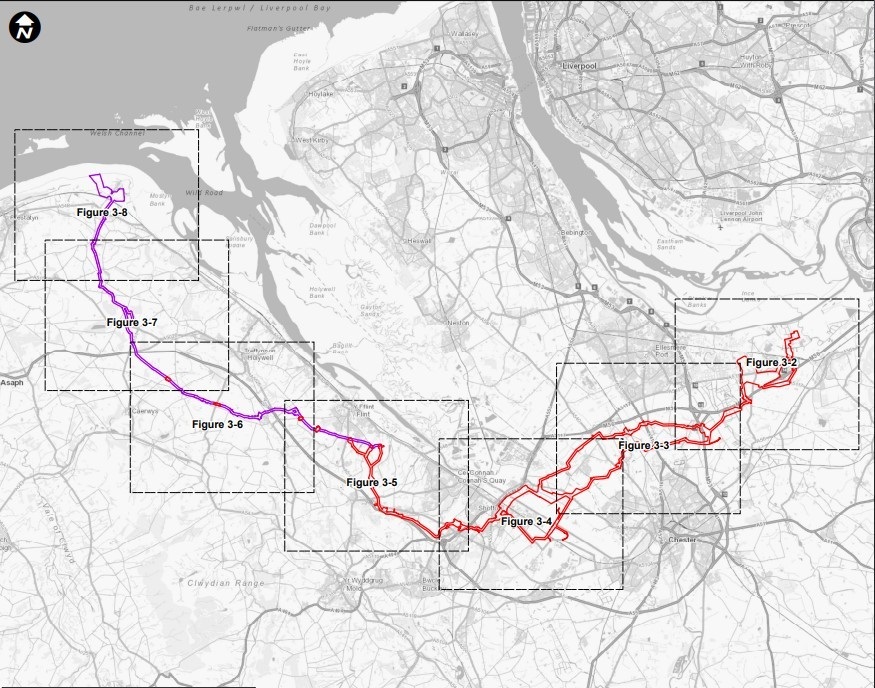Pipeline to carry waste carbon produced in England through Wales to be dumped off the coast

Jez Hemming, local democracy reporter
A proposed pipeline from a massive hydrogen production plant in the north-west of England will carry waste carbon through Wales to be dumped off the coast.
A scoping document submitted to Denbighshire council is inviting the authority to comment on the scheme which will see the waste carbon dioxide ferried along pipes from the north-west of England to a new facility at Point of Ayr.
There it will be pressurised, compressed and stored within existing oil fields off the Flintshire coast.
The pipeline will carry the waste carbon from a 30TWh/yr hydrogen power facility which is planned for Stanlow in Cheshire by 2030. It will produce 30 trillion watt hours of energy annually, enough to power the whole of Scotland for a year with some to spare.
The scheme’s applicant is Liverpool Bay CCS Limited and it will be called the HyNet North West Carbon Dioxide Pipeline.
It will require permission from the UK Planning Inspectorate for the major infrastructure project, with the possiblility of some land needing to be taken using compulsory powers to make it all happen.
Some existing gas pipelines in the north-east of Wales will be re-purposed to accommodate the carbon dioxide, with up to four block valve stations with secure perimeter fencing will be installed along the route.
The pipeline will run around Deeside Industrial Park, through the Flint Mountain site of special scientific interest (SSSI) and across the River Dee special area of conservation (SAC) and SSSI.
The Stanlow to Flint section will be able handle up to 10 million metric tonnes of carbon dioxide each year.
An “above ground installation” will be located on land north-west of Connah’s Quay and south of Flint – called the Flint AGI.
Councillors in Denbighshire have until July 3 to send comments to the Planning Inspectorate about the proposed plan.
Injected
The technology is called carbon capture storage (CCS) and mirrors a project being developed on Humberside.
Pipes measuring between 20 and 36 inches in diameter will run from Stanlow and other industrial sites in north-west England – and feed into the CCS system.
The approach to storing the greenhouse gas most associated with global warming is used successfully at the Hawiyah oil field in Saudi Arabia.
Each day 40 million standard cubic feet of carbon dioxide is transported to the Uthmaniyah oil field and injected into the oil reservoir there.
It leaves the carbon underground and away from the atmosphere while also keeping up the oil pressure in the field.
A similar project to the one suggested for north-west England and the north of Wales is being developed to start hydrogen production and CCS near Hull on Humberside by the mid-2020s.
Carbon dioxide from industry on Teeside will also be deposited as part of the same scheme, in oil fields off the East Yorkshire coast, with the aim of making the area carbon net zero by 2040.
Support our Nation today
For the price of a cup of coffee a month you can help us create an independent, not-for-profit, national news service for the people of Wales, by the people of Wales.






I hear the sound of an absolutely enormous can being kicked along a very long road.
Folly. Pure and simple. Rascals and worse perpetuating the use of fosil fuels and pretending its somehow green. Only GREEN hydrogen is acceptable. This must be opposed at every stage.
Ah there’s a thing….. England gets the jobs, the Welsh coast gets the s**t. Who’d have thought it?
The carbon dioxide is being pumped into empty oil fields. This makes sense for the environment and there is no pollution being generated in Wales.
https://newatlas.com/carbon-dioxide-fuel-conversion-mit/52367/?fbclid=IwAR2_vBTbyWqB81m5SRXH88gX-Z-4epB57vYQA5zY3LkC59nEd8R5yqAr-zg
If the project applicants name is Liverpool Bay CCS Limited then dump it in the Mersey!
It’s going into disused oil wells. It goes the sea and is using a literally empty and useless space.
https://newatlas.com/carbon-dioxide-fuel-conversion-mit/52367/?fbclid=IwAR2_vBTbyWqB81m5SRXH88gX-Z-4epB57vYQA5zY3LkC59nEd8R5yqAr-zg
Out-Bloody-Rageous……and not far from where they are filching Our oil!
That’s the whole point! It’s being pumped into the disused oil fields. It’s a great use of now disused resource and it’s good for the environment.
Don’t worry, Neil McEvoy will campaign on this…oh no, the Welsh establishment f****d him over.
Ffs let’s just get our own gas and coal out of the ground and make an enormous amount of money.
Think you’ll find the voters told him to f**k off…..1% wasn’t it?!? lol
O, Dai bach, I wish I saw things as black and white as you do. But I guess that would mean being as thick as you, too.
Lerpwl … Cofiwch Dryweryn!
Is this another of those “benefits of the union” uncle Boris has been promising us?
Why don’t they use modern technology and adopt the 3 Rs at source, https://newatlas.com/carbon-dioxide-fuel-conversion-mit/52367/?fbclid=IwAR2_vBTbyWqB81m5SRXH88gX-Z-4epB57vYQA5zY3LkC59nEd8R5yqAr-zg They could also use the salt mines in Cheshire for storage, would this be safer than storing Hydrogen there. If they decide they don’t want to use all the latest technology available and embrace it, They could also follow existing pipeline across the south of the Wirral, then go up via Neston, Heswall and then out to sea, a far shorter route. Can there be sure we are not passing a problem on to future generations with the offer of ‘Sorry’